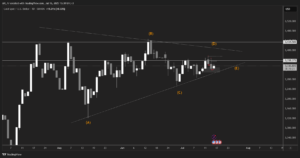Gold prices fell to their lowest level in more than two weeks on Tuesday, amid easing Middle East tensions and profit-taking, as investors await key US data for fresh clues on the Federal Reserve’s interest rate path.
Gold dropped over 2% on Monday, its biggest one-day decline in over a year, as fears of a wider regional conflict eased after Iran said it did not plan to retaliate following an apparent Israeli drone strike. With geopolitical tensions subsiding, investors continue to assess the course of US monetary policy, now expecting rates to remain elevated for longer than previously anticipated.
Gold futures prices – according to the most actively traded contract index – have risen over 11% since the beginning of the year, driven by tensions in the Middle East and amid speculation of US rate cuts. This week, investors will be watching US GDP data on Thursday and personal consumption expenditures (PCE) on Friday.
Gold and the Dollar Now
Gold futures are now down 1% to $2321 an ounce. Spot gold is down about 0.8% to $2308 an ounce. After hitting its lowest level since April 5th earlier in the session. On the other hand, the dollar index is down 0.11% to 105.795 points.
Other Metals
Silver fell 1% in spot trading to $26.93 an ounce, platinum fell 0.1% to $916.10, and palladium fell 0.5% to $1003.50.
Oil Rises in Early Asian Trading as Focus Remains on Middle East
Oil prices rose in early Asian trading on Tuesday, recovering from the previous session’s losses as investors continue to assess the risks posed by geopolitical concerns in the Middle East.
Brent benchmark crude futures rose 39 cents, or 0.5%, to $87.39 a barrel, while US West Texas Intermediate (WTI) futures rose 40 cents, or 0.5%, to $82.90 a barrel. The two benchmarks fell 29 cents in the previous session amid signs that the latest escalation in tensions between Israel and Iran would have little impact on oil supplies from the region in the near term.
However, analysts noted that multiple risks remain in the oil market, particularly after the US approved new sanctions on Iran’s oil sector, expanding existing sanctions to include foreign ports, ships, and refineries (TADAWUL:2030) that deliberately process or ship Iranian crude.
US crude oil inventories are expected to rise last week, while refined product inventories are likely to fall, according to a preliminary Reuters poll of analysts.
Tesla Loses 65% of Its Value!
No one expects Tesla to return to its former glory anytime soon. The stock, now trading at $140, has plunged over 32% in the past three months and lost 65% of its value compared to its peak price in 2021.
Tesla is not only facing stock price crises but also fierce competition from several companies, led by BYD, in addition to numerous technical problems that often force the company to recall many of its models. Tesla has been forced to lower its prices on several occasions due to competition, and Tesla Y prices have recently dropped to $30,000 in a sharp decline. Of course, the decline contributes to reducing the company’s profits and casts a shadow over the movements of investors and traders.
Details of Tesla Stock’s Decline
Last week, Tesla’s stock took another hit after reports that the company plans to cut its global workforce by more than 10%. On the same day, two key executives decided to leave the automaker, including Drew Baglino, Senior Vice President, and Rohan Patel, Vice President of Public Policy and Business Development.
As a result, the company’s stock price has fallen 9% over the past five sessions, bringing its year-to-date losses to over 40%. Reports that the company has scrapped plans for its long-awaited Model 2 have added to its woes. These reports have also had a negative impact on Tesla’s stock, as investors had hoped that this car would solidify Tesla’s position as a mass-market automaker.
Instead, according to a Reuters report, the company will instead focus on developing self-driving robotic vehicles using the same small car platform. Commenting on these headwinds, analysts at Bank of America (NYSE:BAC) said these challenges are “well-known and appear to be priced into the stock.”
While retaining some level of skepticism regarding TSLA’s growth prospects, the bank still sees opportunities for the automaker ahead of “future growth drivers in the coming months, which alone may be enough to support the stock.” In light of this, Bank of America reiterated a Neutral rating on Tesla stock.
For further insights, check OneRoyal’s Facebook, Instagram, and Twitter pages and expand your understanding of financial markets with global perspectives. Staying informed is crucial in the ever-evolving world of finance.
Disclaimer: This article is not investment advice or an investment recommendation and should not be considered as such. The information above is not an invitation to trade and it does not guarantee or predict future performance. The investor is solely responsible for the risk of their decisions. The analysis and commentary presented do not include any consideration of your personal investment objectives, financial circumstances, or needs.





